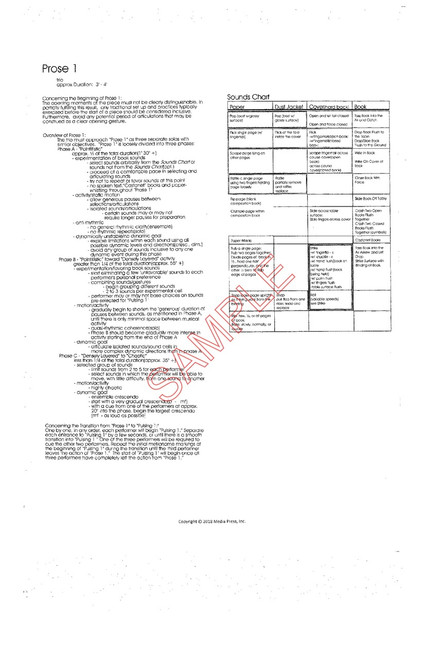Bookoctet, for percussion ensemble, includes one score.
Print size: Letter (8.5 x 11")
Review from Percussive Notes:
Alan Sentman – Bookoctet
“Bookoctet” is a unique piece that is written in the same spirit as de Mey’s “Table Music” and Cage’s “Living Room Music.” Here, eight players are given 50 or more books, some of specific size or construction, to create all the sounds of the work, including ripping, scraping, dropping, shaking, and even being read from. The piece is in three sections. The first is traditionally notated and is the most rhythmically specific. It begins with a unison figure from the entire ensemble. As the piece progresses, select players grab different books and play counter- rhythms that thicken the texture and create a sense of controlled chaos, similar to notated Cage music. These gestures are comprised mostly of triplets, sextuplets, and occasional grace-note figures, all of which are independent of one another. The conductor of the piece is meant to be an ensemble member and thus unable to direct in a traditional fashion, making this the most difficult portion of the work. What follows is a significantly slower section that includes several sound experiments. Each player is instructed to create sounds with the books in unique ways, such as scraping a hard cover with fingernails, shaking an open book, blowing between two pages to make them whistle or buzz, and even destroying a book by “any means necessary.” The final portion requires the performers to read aloud from whatever books are near them, slamming them shut, then repeating the process in quicker succession. The piece ends with only two players reading single syllable words in low voices. The only critique is that the work is written in a full score for each player to read from. As parts are split in the first section and the music becomes denser, the lines that some players read from change. For example, on one page of the work, Player 2 reads from the bottom line of the system, and then on the adjacent page, the same player must read from the top line. These changes are notated using small, bracketed numbers next to each entrance, which are easily missed if reading a part quickly. With proper preparation, any ensemble will be able to work around this, however it will make the early stages of learning the work confusing at times. Regardless of this, “Bookoctet” is a clever and entertaining piece to perform and to watch. It can be used to introduce students to this world of compositions, or for fans of this style to program and celebrate the wide range of capabilities of the percussion ensemble.
—Kyle Cherwinski
Demo:







